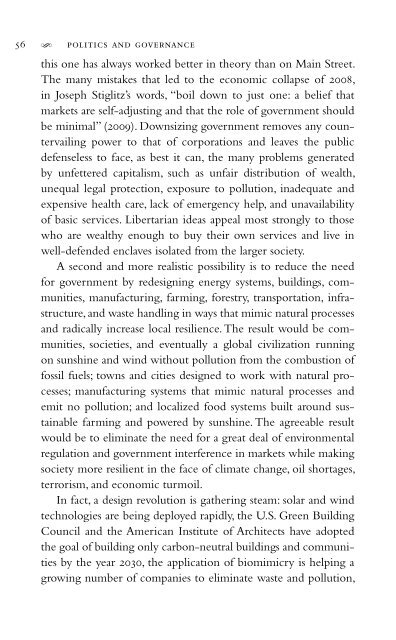Down to the wire : confronting climate collapse / David - Index of
Down to the wire : confronting climate collapse / David - Index of
Down to the wire : confronting climate collapse / David - Index of
You also want an ePaper? Increase the reach of your titles
YUMPU automatically turns print PDFs into web optimized ePapers that Google loves.
S<br />
56 politics and governance<br />
this one has always worked better in <strong>the</strong>ory than on Main Street.<br />
The many mistakes that led <strong>to</strong> <strong>the</strong> economic <strong>collapse</strong> <strong>of</strong> 2008,<br />
in Joseph Stiglitz’s words, “boil down <strong>to</strong> just one: a belief that<br />
markets are self-adjusting and that <strong>the</strong> role <strong>of</strong> government should<br />
be minimal” (2009). <strong>Down</strong>sizing government removes any countervailing<br />
power <strong>to</strong> that <strong>of</strong> corporations and leaves <strong>the</strong> public<br />
defenseless <strong>to</strong> face, as best it can, <strong>the</strong> many problems generated<br />
by unfettered capitalism, such as unfair distribution <strong>of</strong> wealth,<br />
unequal legal protection, exposure <strong>to</strong> pollution, inadequate and<br />
expensive health care, lack <strong>of</strong> emergency help, and unavailability<br />
<strong>of</strong> basic services. Libertarian ideas appeal most strongly <strong>to</strong> those<br />
who are wealthy enough <strong>to</strong> buy <strong>the</strong>ir own services and live in<br />
well-defended enclaves isolated from <strong>the</strong> larger society.<br />
A second and more realistic possibility is <strong>to</strong> reduce <strong>the</strong> need<br />
for government by redesigning energy systems, buildings, communities,<br />
manufacturing, farming, forestry, transportation, infrastructure,<br />
and waste handling in ways that mimic natural processes<br />
and radically increase local resilience. The result would be communities,<br />
societies, and eventually a global civilization running<br />
on sunshine and wind without pollution from <strong>the</strong> combustion <strong>of</strong><br />
fossil fuels; <strong>to</strong>wns and cities designed <strong>to</strong> work with natural processes;<br />
manufacturing systems that mimic natural processes and<br />
emit no pollution; and localized food systems built around sustainable<br />
farming and powered by sunshine. The agreeable result<br />
would be <strong>to</strong> eliminate <strong>the</strong> need for a great deal <strong>of</strong> environmental<br />
regulation and government interference in markets while making<br />
society more resilient in <strong>the</strong> face <strong>of</strong> <strong>climate</strong> change, oil shortages,<br />
terrorism, and economic turmoil.<br />
In fact, a design revolution is ga<strong>the</strong>ring steam: solar and wind<br />
technologies are being deployed rapidly, <strong>the</strong> U.S. Green Building<br />
Council and <strong>the</strong> American Institute <strong>of</strong> Architects have adopted<br />
<strong>the</strong> goal <strong>of</strong> building only carbon-neutral buildings and communities<br />
by <strong>the</strong> year 2030, <strong>the</strong> application <strong>of</strong> biomimicry is helping a<br />
growing number <strong>of</strong> companies <strong>to</strong> eliminate waste and pollution,
















